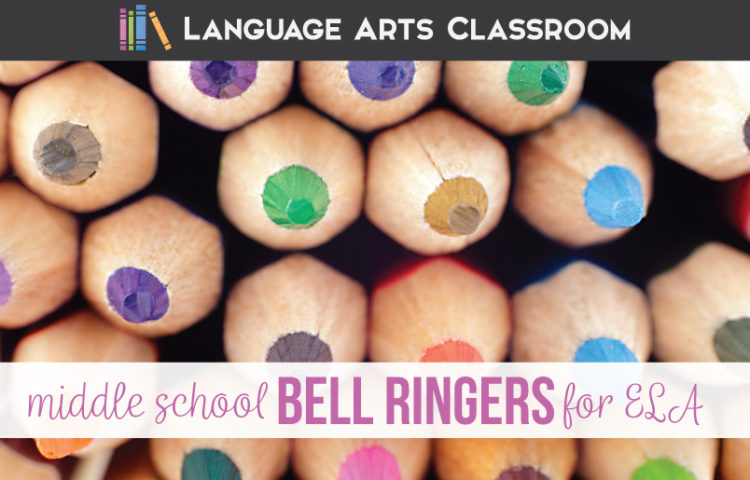Language arts bell ringers for middle school? Start class in an organized way with engaging activities.
Thoroughly making bell ringers for middle school language arts classes can be time consuming, but once you organize the start of your class period, the rest of you class will improve.
When I taught middle school, I used a variety of bell ringers. The key? Consistency. I found what worked for each class and stayed with that tool.

With ELA bell ringers for middle school, I had a couple of approaches:
- I did a different one each day. On Monday we would journal (for example), on Tuesday we would color, and on.
- I would surprise students, but they had a one notebook to record all their answers. Some days we would work on grammar and then the next, writing. But if we were writing in class that day, we would probably independently read. This method allowed me to switch up the day for students.
Organize the bell ringers for middle school language arts for what will make sense for you and your students. Honestly, whatever method I employed mattered less than if I had a bell ringer to start the day. Students expected them, and I could take attendance and start class in an organized way.
Five middle school bell ringers for ELA that worked for me are below, along with a handful of free downloads!
Journal bell ringers.
Writing at the start of a class period makes perfect ELA bell ringers for middle school students. You can grab my free journal sheets to get started.
You can assemble a packet of writing prompts or ask students to use a notebook. Another option is to keep a running Google Slides presentation of their writing. (If you want standard layouts, go to “page setup” and change the dimensions. You can make the slides the typical paper size and insert screenshots of whatever physical journal you have!)
With a digital journal, students can add pictures and images.
If your bell ringers for middle school language arts include journaling, you can then connect those writing ideas to grammar lessons. I often briefly read the journals and gathered common errors to help students understand.
Grammar bell ringers.
Grammar bell ringers for middle school allow me to start with grammar and then connect those concepts to writing or language from reading. As I created these grammar task cards, I had certain goals for them:
- I wanted to make task cards. Individual teachers can add personal touches to task cards. Use them as quiet class work (passing them from student to student around the room, with individual answer sheets), partner work, or group work. You might use these cards for middle school in one way, high school another way.
- I wanted visually pleasing classroom materials. So often older students miss out on the fun layouts from younger grades. Put these in plastic bags or bins to reuse next year.
- I wanted answer sheets for students. Some teachers may not use them (if they have students write on individual cards), but the option is included.
- Finally, I wanted digital options for students who are not present in class.
I print these cards, laminate them, and sort them. Doing so allows me to use them for many years. When students are absent, I share the digital version with them via email.
Overall, grammar bell ringers for middle school address language standards, and I can connect the ideas to student writing, especially if my middle school bell ringers include writing.
Coloring bell ringers.
Sometimes, a middle school class needs to calm down as they enter the room. Middle school bell ringers can include options that you don’t grade. I’ve had classes that I’ve given coloring sheets, and students begin doodling and working on them in a low-stress manner.
When my middle school students returned from lunch, grabbing coloring utensils and coloring sheets provided movement that eventually led to coursework. The entire process became a routine.
I don’t grade these bell ringers, (and often, I don’t grade any bell ringer), but I do connect them to the rest of class by adding notes and examples. Plus, when students finish coloring these sheets, they hang their work—perfect decor!
Infographic bell ringers.
Typically when I assign infographics as bell ringers, I can use the finished projects as part of our anchor charts or bulletin board displays.
If you want infographics for middle school bell ringers, you can create the images (and add shapes and fonts) in Google Slides and have students manipulate them. List a requirement (such as six additional pieces from the main topic), and be impressed with what students build.
Infographics work fabulously for literature and grammar, but you can use them in any area. With infographic bell ringers, I ask students to work for five minutes, and then we continue with class.
Every time I have used infographics as ELA bell ringers for middle school, I am impressed with their creations.

Independent reading as a bell ringer.
Sometimes. . . reading is the perfect bell ringer for middle school ELA.
Students arrive, settle in, and read. No stress, no assignment attached.
After I complete attendance, I sit and read as well. That way, I am modeling reading for students, and I am enjoying myself—reading.

With bell ringers for middle school language arts, the importance is for consistency. When students know how you want them to start class, when they know they’ll start working as they enter the classroom, and when they anticipate the type of work, classroom management will improve.
Your relationships with students will improve too. I hope these ideas for ELA bell ringers for middle school will work in your classroom.
Are you interested in bell ringers for high school ELA? Check out my post about more bell ringers.





